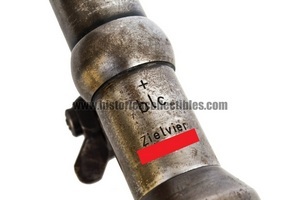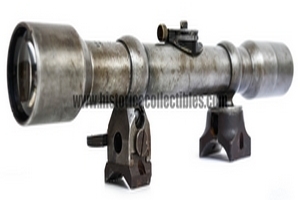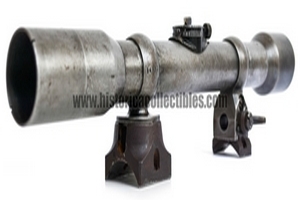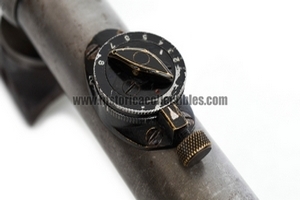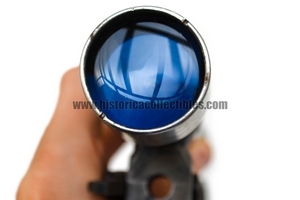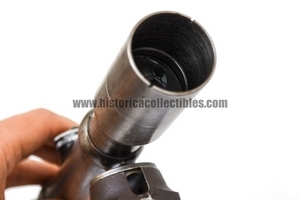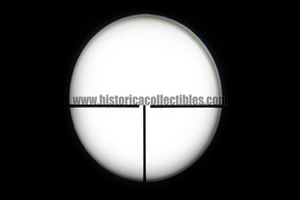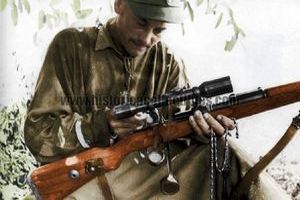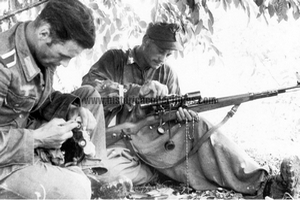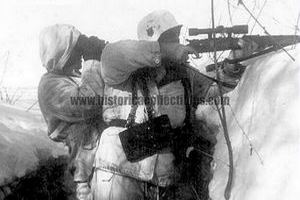Zielvier ZF39 blc (Carl Zeiss) für K98K, Sniper/Scharfschützen, 1939
Sniper Optics mod. Zielvier 4x marked "blc" (Carl Zeiss), made in 1939. This model produced in very few examples was installed exclusively on the K98K sniper rifles supplied to the best German Scharfschützen (snipers) during the Second World War. The optics are equipped with the anti-reflection "blue" treatment (Transparenzbelag) which makes the view exceptionally sharp and bright. The breadth of the field of view with which it is equipped allows the identification of the target extremely quickly, also facilitating the precision of the shot. The mechanism, designed to operate the adjustment of the "T" reticle, has a register for shots ranging from 100 to 800 meters, and a lever placed above it allows you to adjust the focus.
There are two attachments with relative turrets, to fix the scope on the K98K sniper rifle which in this case are strictly original, and are marked respectively with Waffenamt 135 (Manufacturer Mauser) and "M" of which the meaning is currently unknown. What makes this optics more fascinating is the presence of the number "34052" stamped on one of the two rings, which refers to the serial number of the K98K sniper for which it was assigned and installed.
This riflescope, also known as the ZF39 model, is one of the very few known examples bearing the BLC encrypted code of the manufacturing company Carl Zeiss. Above this mark there is the "+" symbol which refers to the characteristics of the grease used, capable in this case of guaranteeing the functionality of the internal mobile mechanisms up to temperatures of -40°. This information suggests that the riflescope was intended for the North Eastern or Russian front.
Carl Zeiss takes its name from its founder, Carl Zeiss, who on November 17, 1846 chose the small town of Jena, in Thuringia, as the location for his precision optical equipment factory.
Thanks to the severe quality control that Carl Zeiss imposed on his products, going so far as to personally destroy the microscopes that did not pass the tests, the newly formed Zeiss became the official supplier of the University of Jena and received the gold medal of the industrial exhibition in 1861 of Thuringia as the best research instrument produced in Germany, awarded to the Stand I microscope of 1857.
In 1866 the thousandth microscope was produced and the name Zeiss became known in all European scientific circles. Thanks to studies on the Porro prism, in 1893 Abbe patented double prism binoculars, which accentuated the perception of depth.
The mass production of Zeiss binoculars began in 1894, already at the beginning of the twentieth century more than 30,000 were made, at the beginning of the First World War the quota had risen to 500,000 and, at the end of the Second World War, as many as 2,260,000 were produced binoculars for the civil and military market. Models were made starting from 4x11 mm to 12x40 mm, up to real giants such as the 80 mm and 100 mm.
Thanks to studies conducted on the perception of light in low light situations, it was demonstrated that the average dilation of the pupil in an adult is approximately 7 mm. For this reason, the 7x50 mm model was introduced in 1910 and remained on the market until 1917 with few changes to the materials used.
In 1926, following the post-war crisis of the First World War with the Treaty of Versailles which bankrupted many important German companies, Zeiss purchased "C.P. GOERZ" and founded Zeiss Ikon in 1926.
In 1937 Zeiss had commercial contacts and factories in more than 29 countries around the world. From '33 Zeiss acquired interest from the Nazi regime, which balanced production towards military instruments.
It successfully produced binoculars with wide-angle optics for military use, pressure-resistant optical systems for U-boats, periscope binoculars for targeting tanks. Furthermore, Zeiss cameras were mounted on the V2s for remote sensing operations of the English coasts.
On 1 November 1935, Zeiss, in the figure of Alexander Smakula, patented a process for the treatment of optical glass with extraordinary results in terms of light transmission. Remained a military secret until 1939, it was adopted on binoculars to reduce ghost images and internal reflections.
During the Second World War, there were numerous bombings against the Zeiss factories. Jena was bombed several times by the Allies starting in 1944. Stuttgart was razed to the ground, although the Contessa-Nettel factory suffered little damage. The bombing of Dresden, in addition to devastating the city, also caused considerable damage to the Zeiss Ikon headquarters.
On April 13, 1945, American military forces entered Jena, surprising themselves that the bombing had not caused any significant damage. The main planetarium was in ruins, while the factories remained operational.

